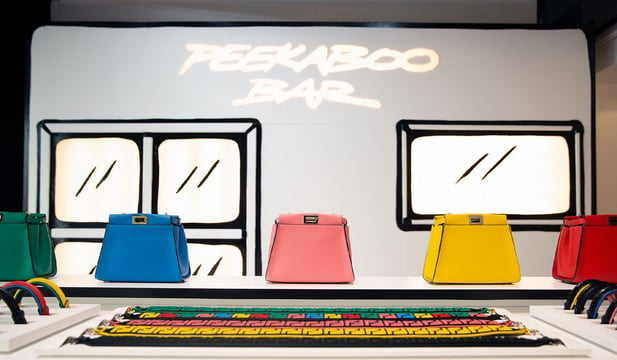Communicating the Brand: The Vital Role of Visual Merchandising

Communicating the Brand: The Vital Role of Visual Merchandising
As brands and retailers increasingly look to pour more money into their online presence, there is a recognizable need to remember the value of physical retail stores to customer experiences and wider brand identity.
More than ever, the physical store has to be looked at as a place to sell more than just merchandise. Modern consumers, especially the millennial generation, crave experiences.
Visual merchandising has changed since the days of the early 1900's department store creative; they are no longer the only communicator of the brand. With most marketing and advertising strategies now reflecting aspirational lifestyle choices, the modern art of visual merchandising must mirror and enhance on this - the storefront window only being the beginning of the reflection.
Visual merchandising must be factored into the business equation in the earlier stages of marketing and product development. It is the first tangible representation of a brand's marketing efforts. In order to communicate the intended messages properly, stores must be merchandised consistently. This requires investment in both time and resources.
While having a strong online presence is necessary in these modern times, retailers must remember to keep investing in the heart and soul of their business - the physical store environment.
COMMUNICATING THE BRAND: THE VITAL ROLE OF VISUAL MERCHANDISING IN OUR CHANGING TIMES
The hallmark of successful retail has always been the ability to adapt to change while embracing the technologies of today. The rate of change in today’s retail environment is exponential. Driven by the unrelenting march of eCommerce technology, retail is changing faster now than ever before. As such, a question is often raised: will eCommerce bring about the end of brick and mortar stores? The answer is a resounding “no”! The future of retail is not brick and mortar or digital engagement; but rather brick and mortar and digital engagement. The two must be spiritually united; the two must work together. The enlightened retailer recognizes that their store environment is their largest asset. The store itself is the embodiment of the brand, and the art and science of visual merchandising positions it as the best vehicle for creating and maintaining long lasting customer relationships. The physical store is the bedrock of omni-channel retailing.
WHILE THE PHYSICAL STORE IS NOT GOING AWAY, WITH 91.9% OF ALL RETAIL SALES STILL BEING TRANSACTED IN BRICK AND MORTAR ENVIRONMENTS, RETAILERS MUST RAISE THE BAR
The physical store is not going away. 91.9% [1] of all retail sales are still being transacted in brick and mortar environments. Retailers must therefore remember to balance technology investment between stores and eCommerce. They must invest in providing a reason for customers to visit their stores. It is important to recognize that the physical store is a tool of communication - the best place to articulate quality messages to the targeted customers. Retail stores are naturally the showplace for new ideas, new concepts, and new products. As such, the physical store becomes a selling stage for those new products. New products, the latest fashions and trends, are all very exciting. Retailers must capture that excitement and communicate it through the language of visual merchandising.

Kylie Jenner Pop-up, Galeries Lafayette.
To communicate this story, the physical and digital worlds of retail must work together. And while retailers integrate technology into their business strategies, as well they should, it is important to remember that eCommerce is not the only vehicle for communicating this story. Rather, the role of technology is to help tell the story across all channels. The focus today for brick and mortar must continue to be on the beauty of the store and the presentation of the merchandise. As such, it is vital that retailers factor visual merchandising into their company culture and corporate DNA.
The role of visual merchandising has changed dramatically since its inception in early 20th Century department stores. Back then, every major retailer had a ‘creative’ burrowed away in the far corner of the basement of the store. This flamboyant individual had a studio filled with birds and flowers, colored papers and glass, crystal chandeliers, wine coolers, exotic fabrics, and other assorted items and curiosities. All were props to highlight single pieces of merchandise. He was a showman, and all too often his theatrical productions would totally overwhelm the merchandise.
Visual merchandising has now become more about reflecting our times, our values and our aspirations. Today, the perceptive retailer, who is in touch with our changing times, sits next to the visual merchandiser in the executive boardroom. Visual merchandising has gone from birds and flowers in the basement studio, to decision making in the corporate office. It has become an integral component of any retail strategy, and it must be factored into the business equation in the early stages of development.
VISUAL MERCHANDISING HAS NOW BECOME MORE ABOUT REFLECTING OUR TIMES, OUR VALUES AND OUR ASPIRATIONS
Going forward, it is imperative that retail strategists recognize the importance of the store environment as a critical touch stone of the brand. Every gesture that a retailer makes, from the sign above the door to the mat below - from the nature of the sales associates to the surface treatments on the walls; from the stationery they use to the merchandising standards and techniques they employ - must be in sync with the brand image they hope to project. It must be noted that visual merchandising is not only the communicator of the brand, but also the keeper or the brand. Through visual merchandising, the retailer clearly states who they are, what they have to say, and how they say it. Today more than ever, the physical store has to be looked at as more than just a place to sell merchandise. It should be considered as a point of connection between retailer and consumer. When designing a store today, retailers are charged with designing more than a place to sell. Rather, they are designing an experience. The constructs of experiential retail are built upon effective visual merchandising. Today’s customer wants an experience, and visual merchandising is the most effective tool to provide that experience.
Visual merchandising is the moment of truth. It is the deliverance of the promise and the fulfillment of the expectation. It is in fact, the last link in the marketing chain. Everything ever said in the marketing campaign falls under a magnifying glass when the customer enters the store. Visual merchandising is the first three dimensional representation of the marketing effort, and the first tangible expression of anything ever promised. Today, a strong visual merchandising point of view and strong visual merchandising standards, are critical for success.

Concise and consistent standards ensure that the brand image and the nuances of the product offerings are accurately represented in every store. Success in retail is built upon effective communication. The role of today’s visual merchandiser is to set presentation standards and project meaningful brand messages. The corporate director of visual merchandising must work with every division within the company, from store design, planning and buying, to merchandising and operations, to develop these concepts and then to communicate clear directives to every store under the company umbrella. These standards and messages must be accurately and consistently executed in every door. Every store is a brand ambassador. As such, every store must communicate the same message as each will leave a lasting and indelible impression.
VISUAL MERCHANDISING IS THIS COMMUNICATOR - THE VEHICLE THAT CONTINUES TO CREATE A HOLISTIC DIALOGUE WITH ALL WHO ENGAGE WITH THE BRAND
As retail continues on its grand evolutionary path, it’s interesting to note that Amazon, Warby Parker, and Bonobos, leading e-commerce retailers, have all brick and mortar stores. All three online giants recognize that brick and mortar environments support on-line sales.
The roadmap to success in today’s changing environment is clear. As retailers craft strategies for future growth, and in some cases survival, they must recognize that the foundation for success is based on the footing their business is built upon. While we are fully engaged in an omni-channel retail structure, the physical store remains the most important stepping stone on the path to purchase. Any master plan designed to foster retail growth must leverage existing and new technology not only as a portal for customer engagement, but also as a vehicle to enhance the in-store experience. The lifeblood along the path to purchase is the necessary allocation of resources to enhance the customer experience in the physical store. And while investing in a strong on-line presence is necessary, retailers must invest equally in the heart and soul of their business; the physical store environment.
To succeed, retailers must establish clear and consistent channels of communication between themselves and the targeted consumer. While eCommerce offers an efficient means of communication, there is still an important amount of sensory information that is lost. Physical stores retain this, and create a much more tangible form of communication between brand and consumer.
Visual merchandising is this communicator - the vehicle that continues to create a holistic dialogue with all who engage with the brand.
[1] U.S. Census Bureau News, Department of Commerce, Washington, D.C. August, 2016
About Eric Feigenbaum
Eric Feigenbaum is a recognized leader in the visual merchandising and store design industries with both domestic and international design experience. He served as corporate director of visual merchandising for Stern’s Department Store, a division of Federated Department Stores, from 1986 to 1995. After Stern’s, he assumed the position of director of visual merchandising for WalkerGroup/CNI, an architectural design firm in New York City. Feigenbaum was also an adjunct professor of Store Design at the Fashion Institute of Technology and formerly served as the chair of the Visual Merchandising Department at LIM College (New York) from 2000 to 2015. In addition to being the Editorial Advisor/New York Editor of VMSD magazine, Eric is also a founding member of PAVE (A Partnership for Planning and Visual Education). Currently, he is also president and director of creative services for his own retail design company, Embrace Design.
Follow IWD on Facebook, LinkedIn and Instagram or subscribe to our newsletter.
MORE ARTICLES BY THIS AUTHOR

Eric Feigenbaum




